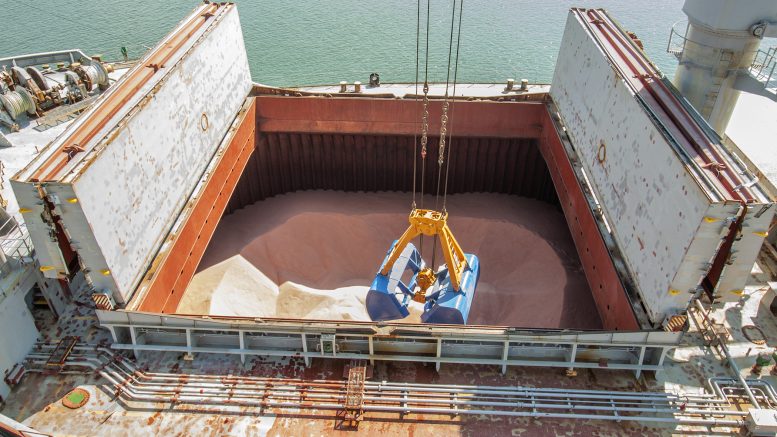Brazil’s Fertilizer Imports From Bolivia up Nearly 50%
Brazil
In compliance with the court decision, Anvisa approves 4 toxicological evaluations: pyraclostrobin 133 + epoxiconazole 50 g/L SE (Rainbow); 2,4-D 806 g/L SL (Perterra); malathion 876.66 g/kg EC (CHDS); imidacloprid 250 + bifenthrin 50 g/L SC (Tecnomyl). (Anvisa)
Haifa, an Israeli fertilizer company, inaugurated its first speciality fertilizer mixer in Latin America in Uberlândia, State of Minas Gerais. With an area of 20 thousand m2, the automated unit begins operation with a capacity for 6 thousand tonnes of fertilizers per year. Within five years, the company plans to expand capacity to 20 thousand tonnes. (Haifa Group)
More than 800 thousand tonnes of empty pesticide packages were disposed in an environmentally responsible manner, which is a historic record. This number reinforces Brazil’s global leadership in reverse logistics in agriculture. In 2024, 68.5 thousand tonnes of packages were returned by farmers, which is 27% more than in the previous year. (inpEV)
From January to September of 2024, Brazil recorded a 10.9% increase in areas treated with pesticides, exceeding 1 billion hectares. This expansion was driven by soybean (35%), corn (27%) and cotton (12%). The most used categories were herbicides (45%), insecticides (26%), fungicides (20%), seed treatments (1%), and other products (9%). (AgroReceita Receituário Agronômico)
According to João Luiz Ricardo de Souza Filho, associate at IEST Group – Consultoria Empresarial, the increase in fertilizer imports has worsened problems with counterfeits and low-quality products. According to Souza Filho, prices well below the market and promises of easier logistics tend to generate distrust, making transparency fundamental in negotiations. (IEST Group)
Fertilizer imports reached a five-year record in 2024. Around 44.3 million tonnes of inputs were unloaded in Brazilian ports, an increase of 8.3% when compared to 2023. (Conab)
Mining company BHP is closing agreements with partners in Brazil for potash distribution. The objective is to guarantee the flow of product from the mine being implemented in Canada, which should be the largest in the world, when it reaches its maximum capacity, in 2031, of 8.5 million tonnes per year. (BHP)
Operation carried out by the State Police Division for the Suppression of Rural Crimes and the Rural Battalion of the Military Police dismantled a criminal group specialized in theft and reception of pesticides. The action resulted in the seizure of 958 units of illegal pesticides, two vehicles used to transport illicit products and the arrest of suspects. The investigation began after the theft of pesticides valued at US$ 102.56 thousand from a farm in Aruanã, State of Goiás. (Decrr; BPMRural)
The Board of Directors of the fertilizer company Fertilizantes Heringer has elected Fausto Pereira Goveia to be the new Financial Director and Investor Relations Director. (Fertilizantes Heringer)
According to a survey carried out by the maritime agency Williams Brasil, 6.667 million tonnes of fertilizer are scheduled to be imported between January 1 and 27, and should arrive by April 30, 2025. The port of Paranaguá, in the state of Paraná, will unload the largest part, totaling 1.940 million tonnes. This is followed by the port of Santos, SP, with 1.887 million tonnes. The report takes into account vessels already at anchor, those waiting to dock and those expected to arrive. (Williams Brasil)
Sinara Giombelli Ferreira leaves her position as Business Director at FMC in Brazil after 23 years at the company. (FMC Corporation)
Researchers analyzed advances in biological control of Drosophila suzukii, a pest that affects fruit crops. The study, which reviewed 184 publications between 2012 and 2023, highlighted parasitoids as the main control agents, with an emphasis on the species Trichopria drosophilae and Pachycrepoideus vindemmiae. The review also identified advances in the use of entomopathogens. Fungi such as Beauveria bassiana and Metarhizium anisopliae have demonstrated a high infection rate against D. suzukii in the laboratory, but their application in the field still faces challenges. Bacteria such as Xenorhabdus nematophila and Bacillus thuringiensis also showed lethal effects on the pest’s larvae. (MDPI)
Ministry of Agriculture has declared a phytosanitary emergency in the States of Amapá and Pará due to the risk of an outbreak of the quarantine pest Rhizoctonia theobromae. Ordinance No. 769 establishes the emergency status for one year. (MAPA)
The City of Paranavaí, State of Paraná, started cutting down all citrus trees as well as the ornamental plant myrtle (Murraya paniculata) in the urban perimeter. The objective is to eliminate psyllid host plants, which is responsible for spreading greening. (Adapar)
Seiva Sul Mineração has obtained a Preliminary License to manufacture fertilizers in the city of Candiota, State of Rio Grande do Sul. The license, issued by the State Foundation for Environmental Protection, is valid until 01/14/2030. (Seiva Sul Mineração Ltda.)
The State of Acre exceeded 1.8 million liters of pesticides used in 2024, in which four municipalities concentrate more than half of total. According to the study, the municipality with the greatest use of pesticides was Xapuri, with 287.2 thousand liters. (IDAF)
Delays in cotton sowing in the State of Mato Grosso may cause significant losses to yields and fiber quality and affect the planning of subsequent harvests. According to Sidnei Douglas Cavalieri, researcher at Embrapa’s Cotton Unit, the ideal sowing is in January. When sown from February onwards, cotton may face water stress, increased presence of weeds and negative impacts on crop rotation. The delay can also generate additional costs with herbicides. (Embrapa)
There was a considerable reduction in the number of soybean Asian rust outbreaks in 2024. The decrease in rainfall in the South and high temperatures helped to slow down the fungus spread. Although the disease has decreased in the States of Paraná and Rio Grande do Sul, it is still necessary to be carefull, according to Embrapa’s researcher Claudia Godoy. “Rust is the most severe soybean disease, and its occurrence depends mainly on climatic conditions… the control needs to be rigorous to avoid large losses”. (Embrapa)
Lavoro recorded consolidated revenue of US$ 351 million in the 1Q2025, a drop of 13% when compared to the same period in 2024. The reduction was influenced by deflation in input prices in agricultural retail in Brazil, although the “Crop Care” segment has shown growth. (Lavoro Agro)
Environmental inspection at an unlicensed fertilizer company results in an attachment and fines worth US$ 60.07 thousand in the city of Apucarana, State of Paraná. According to the Environmental Military Police, an anonymous denouncement reported an environmental crime. The police team went to the location of the complaint and, during the inspection, confirmed the company was manufacturing organic fertilizers reutilizing wastes, but it did not have environmental licensing, and the materials used were stored outdoors, exposed to the weather. (Military Environmental Police)
Brazilian Export and Investment Promotion Agency launched the Fertilizer Sector Investment Attraction Program – Invest in Brazil Fertilizers, during the event Fertilizer Latino Americano 2025, held from January 26th to 29th in Rio de Janeiro. The program aims to reduce foreign dependence on fertilizers by identifying strategic projects in Brazilian States to attract international investment. (ApexBrasil)
Border Operations Department seized 3.5 tonnes of illegal pesticides, valued at approximately US$ 604,490, during a patrol on MS-164 in Ponta Porã. (DOF; State Department of Justice and Public Security; Ministry of Justice and Public Security)
Embrapa and Fundação Meridional have launched the soybean cultivars BRS 2361 I2X and BRS 2058 I2X, featuring tolerance to glyphosate and dicamba, resistance to pests, and high yield potential. The Intacta2/Xtend (I2X) technology protects against six caterpillar species, requiring refuge areas to prevent resistance. (Embrapa; Fundação Meridional)
Act No. 3 published in the Federal Official Gazette, withdrawals 7 pesticide registrations. (Ministry of Agriculture)

Latin America
National Agri-Food Health and Quality Service of Argentina has prohibited the post-harvest uses of products based on malathion in stored corn grains. (Senasa)
Jeremías Battistoni, an analyst at AZ Group, from Argentina, analyzed prices in the agricultural input market. Urea rose on the international market, with an FOB price in the Middle East of US$ 378 per ton. Locally, urea is trading at an average of US$ 492 per ton. The agrochemical market has seen decline in prices in several products, specifically in glyphosate. There were also declines in atrazine and 2,4-D. An important topic to be monitored is the recent change in export taxes (retenciones), which could generate a short-term increase in grain prices. (AZ Group)
Fertilizer consumption in Argentina dropped by 5% in 2023/24, totaling 3.9 million tonnes. Nitrogen fertilizers rose to 63% of the market, while phosphates fell to 37%, with reductions in corn, wheat, and soy. (Buenos Aires Grain Exchange)
Approximately 500 thousand farmers in the department of Cochabamba, Bolivia, will have access to NPK fertilizers offered at lower prices after an agreement with the Bolivian Hydrocarbon Industrialization Company. “It is estimated that around 500 thousand farmers will benefit from access to fertilizers NPK 20-20-20, NPK 22-8-15 and slow release urea at wholesale prices”, informed the State-owned company. (EBIH)
Purchase of fertilizers from Bolivia by Brazil recorded a growth of almost 50%, with highlights on urea and potassium chloride, according to the consul general of Brazil in Bolivia, Francisco Soares. “Last year there was an increase of almost 50% in the acquisition of the several fertilizers we purchased from Bolivia.” In plants located in the departments of Cochabamba and Potosí, Bolivia produces urea, potassium chloride and NPK. The production of Bolivian fertilizers is carried out by the state-owned Yacimientos Petroliferos Fiscales Bolivianos, which produces urea; Bolivian deposits of lithium, potassium chloride; Bolivian Hydrocarbon Industrialization Company, NPK. (Brazilian Consulate in Bolivia; YPFB)
Beekeepers request for the end of fipronil use in Campeche and Hopelchén, Mexico, due to the death of bees. According to beekeepers, in 2023 and 2024 the use of the pesticide would have caused the death of more than 4 thousand hives, with an estimated loss of US$ 700 thousand. (PRI)

READ MORE:

